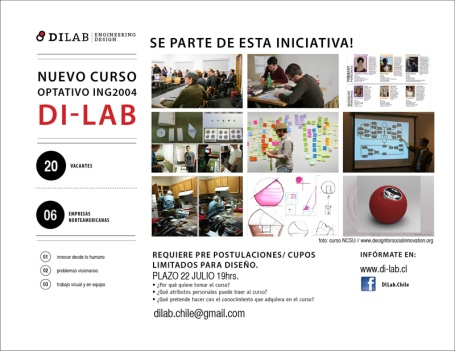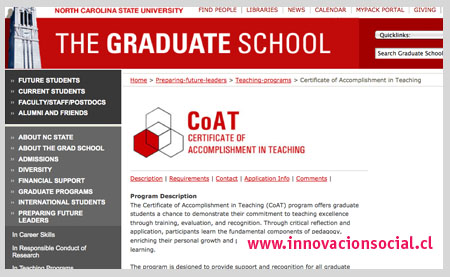{DESIGN AND SOCIAL INNOVATION} Building capabilities in communities by instructing engineering-design skills
Original post at the DILAB:Engineering Design Initiative

Picture: JangoTec session in La Granja 2014
{ENG} Many people refer to the concept of social innovation as something enacted by a stranger to a community that “needs” help. We’ve explored and reflected over this extensively on our”design for social innovation” website. There are different takes on the concept. In our experience, there are few individuals promoting social innovation that seek to empower communities to build their own solutions or believe in changing or adapting their own fate. Looking to fulfill our interest in community building and empowerment, the DILAB staff, together with the student movements: Convive and La Resistencia, decided to create an educational hands-on program for the democratization of some of the skills that engineer-designers get at the Católica School of Engineering. These include: technology, establishing networks and prototyping. The project is called JANGOTEC: “A Journey from our talents to new capabilities.” This is a space of learning and approach to technology.
Principles that inspire us: “We all have creative potential”, “We’ve done a lot with little”, “We are building a floor to get high” and “We can.”
…………………………………………………………………………………………………
{ESPAÑOL} Mucha gente habla de innovación y mucho más de la innovación social. Es un tópico bastante explorado (more…)
Where am I today doing Design for Social Innovation?
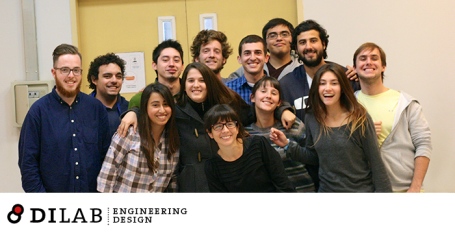 It’s been a long time since I have not written any post for this blog! Today I am at Escuela de Ingeniería PUC in Santiago de Chile becoming an intrapreneur. Just as Steve Jobs formed a group of people within Apple to develop the Macintosh, “going in essence back to the garage” (Jobs, as told to Newsweek in 1985), we have developed (together with Catalina Cortázar ) the DILAB, Engineering Design Initiative at PUC. This Design-Anthropology lab has been developed in a prestigious school of engineering in Latin America, serving more than 1,000 students a year and connecting with schools and companies all around the world.
It’s been a long time since I have not written any post for this blog! Today I am at Escuela de Ingeniería PUC in Santiago de Chile becoming an intrapreneur. Just as Steve Jobs formed a group of people within Apple to develop the Macintosh, “going in essence back to the garage” (Jobs, as told to Newsweek in 1985), we have developed (together with Catalina Cortázar ) the DILAB, Engineering Design Initiative at PUC. This Design-Anthropology lab has been developed in a prestigious school of engineering in Latin America, serving more than 1,000 students a year and connecting with schools and companies all around the world.
The lab is promoting educational content that used to be foreign for the core of engineering in this country. It mainly provides design-anthropology knowledge and tools to engineers engaged in the area of mechanical construction and robotics, as well as to those who are more business oriented. The lab is fostering an alternative pedagogical culture to the one obeying the ‘assembly-line-instruction’ (Rogoff, 2011) typology. This new model coaches critical thinking skills through applied, real-world experiences with organizations where the students become the protagonists. Rather than solving exercises in a vacuum, this gives students a sense of applied reality to their learning. Check out the initiative and our Facebook page.
DI-LAB: New course in Santiago de Chile for Engineering Design
Pic: Compiled images from experiences at NC State
Having a big interest in education, as a method to achieve transformation, we will impart an innovative course in Santiago de Chile starting in August 2013 at the School of Engineering at PUC. The DI-LAB is a unique course for all engineering and design specialties where the students engage with an American-based company in solving an ill-defined forward thinking “issue”. It works with design-anthropology, negotiation and visual thinking among other lines of thought. The companies that will partner with us entail a wide range of typology, from successful ex-startups to big companies that are leaders in their area. The companies are: Design Central, Teague Associates , Oracle , Ziba and Artefact . If you are an engineering student at PUC you can get more information at www.di-lab.cl . Like us on Facebook in order to get our latest news.
If you are not a student at PUC or you are out of school already, don’t worry, we love open source! We will be posting interesting stuff on the student’s process at the DI-LAB website and on our Facebook page .
CoAT Program: Training graduate students to become better educators
This post does not only entail education in Design or Engineering. It touches upon the CoAT program at NC State University, in the US, which is part of the PFL (Preparing Future Leaders) program. The Certificate of Accomplishment in Teaching (CoAT) is an initiative from the graduate school for developing pedagogy skills in graduate students from different disciplinary backgrounds. These g.students will soon become the educators of future professionals. Being close to people (including myself) that came to the US with a focus on improving Latin American education (to achieve equality), this program caught my attention. Furthermore, having experienced it made me a believer that programs like this make a difference and have an impact in an educational environment. This was my experience:
As a Design PhD student and instructor (from 2009-2013), me, and a group of other PhD students, fulfilled a series of workshops focused on higher education instruction. In addition, we were exposed to “actual hours of instruction” where (more…)
Reflection on Entrepreneurship. Ideas to Reality. The Critical Story Behind Creating Self-Watering Seed-Starters
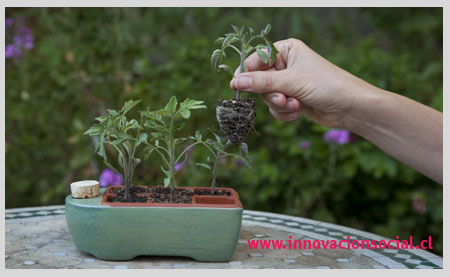 Pic: Anne Fletcher’s Self-Watering Seed-Starter (Orta)
Pic: Anne Fletcher’s Self-Watering Seed-Starter (Orta)
Studying in the States, I’ve been exposed extensively to entrepreneurship. Most of my good friends with good ideas make them work and turn them into reality. The entrepreneur spirit is in all of those who work hard, and believe that they have something to improve others daily living. This is what happened with my friend Anne Fletcher, instructor at the D.School and consultant. After showing off her entrepreneur skills in Chile’s surfing context, she came back to the States, and here, she is doing it once again. Meet her dream of helping others to keep seedlings alive. But is not that easy! There are pitfalls and a-ha moments! It is always good to hear a real story and reflection, overall from someone who is critical and has a vision behind it. Here is what she tells us about her quest:
-. I find hope in planting seeds .-
Terracotta self-watering seed-starters will keep your seedlings alive even if you ignore them a little! Before I started making terracotta seed-starters in my garage, I killed a lot of seedlings. In the delicate seedling phase, plants need gentle watering every single day, twice a day if it’s hot outside. With long hours and work travel, sometimes it just wasn’t possible for me to keep those baby plants alive. About a year ago I had an idea for a new way to solve this problem. I invented a terracotta self watering seed-starter with a reservoir for water, and porous walls that keeps seedlings happy for about a week between waterings. After debuting my invention last September, I started selling out all the production runs I could make in my garage. I found some local artisans here in California to help me meet the growing demand.
Now I’m working on a new, bigger model. The 12-pack allows you to grow bigger seedlings, and more of them. Big is great for the plants, but it’s too much for me to handle in the garage. I’m doing a Kickstarter project to raise the funds to make the 12-pack a reality by paying for professional mold-making, and working with manufacturing partners in California. This project partly comes from a desire to keep my plants alive in a pretty package on the windowsill – there’s no denying that. But there’s another deeper reason.
As a designer, I struggle all the time with the visions of apocalyptic futures that experts say are coming if we don’t change our consumption habits. When I ponder the designer’s role in all this (as creator of objects people desire, and sometimes as creators of the desire itself), I feel a mental paralysis. It’s extremely difficult to balance both being aware of what we humans are doing to ourselves, and yet stay positive enough to have the energy to make positive changes. In a world sharply divided between doom-and-gloom apocalysm and head-in-the-sand optimism, we designers need a new way forward. I can’t ignore the reality of our current situation, yet I also can’t create positive change from a place of fear and pessimism. -. I find hope in planting seeds .- (more…)
Good Tools: Mendeley An Open Source/ Social Media Reference Manager
 Pic: Mendeley’s Website Screenshot
Pic: Mendeley’s Website Screenshot
Many of the graduate students, as they leave school, they have to leave behind the subscriptions to things like their “Reference Management Software” (End Note, RefX, etc). My advice, after going through my doctoral studies is: DO NOT USE LICENSED BASED REFERENCE MANAGEMENT SOFTWARE! It is most likely that you will end up switching jobs, countries, universities or even migrating from your computer operating system. Even though for some of these licensed software have some web based components, their penetration in particular communities depends if someone is sponsoring the license payment or not.
Even though I started using a licensed software at the beginning of my PhD program at NC State, I opted to try out Mendeley, a web-based reference manager that entails social media tools to connect with other researchers on the web. Mendeley provides you with a desktop tool where you can just drag and drop papers in order to have a copy in your reference manager. It also allows you to highlight (mainly the actions that Acrobat PRO provides) and write notes in the document that you can later access in your smartphone, tablet or computer. You can also join other researchers in groups of interest where you share bibliographic references online. Not everything is perfect in Mendeley though. There are issues on their importing plug in for Firefox and other small issues. But it is a pretty amazing FREE TOOL (Open Source) that you can use in your endeavors or with educating young researchers or students into better practices for working with bibliographic references.
Chilenos en Papel: Giving Back to People in a Visual Way
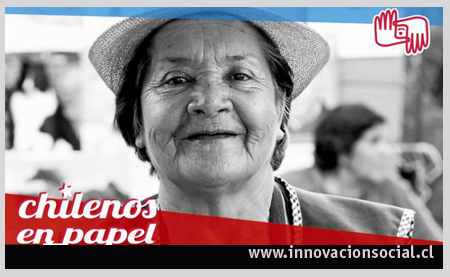 PIC: Alejandro Blanco
PIC: Alejandro Blanco
Not long ago DFSI showcased the work of Saul Flores in his visual work “Footprints: the Walk of Immigrants”. This time, I came across a great project from photographer Alejandro Blanco and psychologist Catalina Correa : “Chilenos en Papel“. This ambitious visual project seeks to recover the cultural patrimony related with the social capital of Chileans and their traditions. One of the most interesting things is their idea of “giving back” to the community. This is not that usual for our tradition in Anthropology, but with the technological advances in photography, processes have become more affordable and democratic…and this project embraces that. Here is what they write:
CHILEANS ON PAPER
Alejandro Blanco, photographer
Catalina Correa, psychologist
IDEAME Fundraising URL
We all love watching pictures that bring us memories of important moments or people that have been meaningful in our lives. But people living in remote or (more…)
Serendipity in Ethnography: Some things I learned during my doctoral field research
 During the last doctoral colloquium at the EPIC conference I was going to present some of the findings from my doctoral research. At the last minute, however, I decided that it would be more useful to talk about my personal design-anthropology journey during my ethnographic fieldwork for others to learn from my experience. If you are a veteran in ethnography, this might sound like ethnography 101, but the truth is that all experiences are different, and in my opinion, as an academic, it is always good to reflect on them. The beauty of research, when it is applied, is that all the clean theoretical assumptions can be “dirtied” with the facts of reality. As Herbert Hyman said:
During the last doctoral colloquium at the EPIC conference I was going to present some of the findings from my doctoral research. At the last minute, however, I decided that it would be more useful to talk about my personal design-anthropology journey during my ethnographic fieldwork for others to learn from my experience. If you are a veteran in ethnography, this might sound like ethnography 101, but the truth is that all experiences are different, and in my opinion, as an academic, it is always good to reflect on them. The beauty of research, when it is applied, is that all the clean theoretical assumptions can be “dirtied” with the facts of reality. As Herbert Hyman said:
“All scientific inquiry is subject to error, and it is far better to be aware of this… ”
His main message was that is not necessary to conceal error, but to learn how to work with it. If we are dealing with human participants and we, humans, are instruments of research, it would be naive to think that error is not going to be present. We are not in a sterilized lab. Having read a bunch of heavy ethnographic research theory books, and also having undertaken research quests in the applied world, Harry F. Wolcott’s most basic book, Ethnography Lessons: A Primer, was (for me) the only one that approached the truth in the raw. He describes, based on his own experiences, what can go right or wrong in ethnographic research endeavors.
This post covers some practical knowledge gains by looking in retrospective to my serendipitous 8-month ethnographic research with graduate engineering student teams in their university environment. I thought I was completely prepared, as I had read and planned for things to happen in my research proposal, but reality set in once I was on the ground gathering my data. i realized things worked in diverse ways and I just had to learn to navigate each and every situation separately. Considering this is a blog post, I will just go forward and talk about some practical advice and ways to navigate the situation when unexpected or relevant issues come up.
SOME OF THE THINGS I LEARNED: HOW TO NAVIGATE
LESSON 1: A WATCHED POT NEVER BOILS
What happens when you are living to close to your subject? When there is no (more…)
Good Primers for new design approaches: some good reads in Design and Thinking (don’t underestimate that comma)
One of my friends who working for “Teach for All” asked me today about good readings for a quick immersion on Design. Why? Because design strategies seemed appealing for them as a form of “elicitation of creativity and participatory work among organizations. I didn’t want for him to be trapped in the “Brainstorming/ Post It” cloud, which is usually what consultancies offer. So here are some of the readings that I thought could be more helpful in clarifying the picture on design.
NOT DESIGN THINKING AGAIN!
First a disclaimer. As Lucy Kimbell states (quoting Rylander 2009), “it’s hard enough understanding design and thinking, let alone design thinking. So it is not a surprise that those who support its application to business or more broadly to public services or social problems, have trouble articulating what it is, whether all designers can do it…” The articulation of “Design Thinking” is messy, and yet, for me, OVERUSED! So please do refer to particular aspects of design when you are working within these matters. A bunch of the design thinkers can be categorized as “snake charmers” or “encantadores de serpientes” like we would say in Spanish. The same goes to the so-called “innovation” term.
1. THE DESIGN THINKING BUZZ
 Being consequent, I would begin reading Lucy Kimbell’s article “Rethinking Design Thinking“ published on the 3d Volume of the journal “Design and Culture”. In this article she puts forward a lot of the controversies that design practice and recent theory-building (mostly translated to the business world) brings. It highlights the strengths of design and its biggest problem. Also, it touches on the history that most people don’t know about. The pre–IDEO, pre-marketing buzz Design-Thinking term. Read this article in order to get a grasp of what real designers do, and what real design oriented researchers or thinkers have written about in the past. As a researcher and design-anthropologist, I value the critical thinking Kimbell poses and the way she draws a line between management and a more cognitive and culturally sensitive form of design thought configuration.
Being consequent, I would begin reading Lucy Kimbell’s article “Rethinking Design Thinking“ published on the 3d Volume of the journal “Design and Culture”. In this article she puts forward a lot of the controversies that design practice and recent theory-building (mostly translated to the business world) brings. It highlights the strengths of design and its biggest problem. Also, it touches on the history that most people don’t know about. The pre–IDEO, pre-marketing buzz Design-Thinking term. Read this article in order to get a grasp of what real designers do, and what real design oriented researchers or thinkers have written about in the past. As a researcher and design-anthropologist, I value the critical thinking Kimbell poses and the way she draws a line between management and a more cognitive and culturally sensitive form of design thought configuration.
2. INTERACTION DESIGN
 A component that has been critical to design, or at least on how we use design nowadays, is “Interaction Design”. As mentioned before in this blog, interactions “are said to frame the relationship between people and a variety of artifacts like products & systems, which convey the aspect of function, which has always been part of design [Dubberly, Pangaro & Haque, 2009] “. Interaction design has migrated from what was software or Internet design to what is design in products, systems and even social systems. To learn about this I would recommend:
A component that has been critical to design, or at least on how we use design nowadays, is “Interaction Design”. As mentioned before in this blog, interactions “are said to frame the relationship between people and a variety of artifacts like products & systems, which convey the aspect of function, which has always been part of design [Dubberly, Pangaro & Haque, 2009] “. Interaction design has migrated from what was software or Internet design to what is design in products, systems and even social systems. To learn about this I would recommend:
 To know about history I would get Moggridge’s (RIP) “Designing Interactions” (The MIT Press), which is an easy to read history compendium of interviews with designers related with this matters. Dan Saffer‘s (ex Adaptive Path) “Designing for Interaction” is an easy recipe-like paperback edition that will give you applicable knowledge on how to use interaction design techniques. So you can think on users and people in general in order to make better design solutions.
To know about history I would get Moggridge’s (RIP) “Designing Interactions” (The MIT Press), which is an easy to read history compendium of interviews with designers related with this matters. Dan Saffer‘s (ex Adaptive Path) “Designing for Interaction” is an easy recipe-like paperback edition that will give you applicable knowledge on how to use interaction design techniques. So you can think on users and people in general in order to make better design solutions.
Lastly but not least, there is a powerful interaction design tool that is called “Personas”. This is a tool that is used more and more to create empathy between designers and the end-user of their creations. I’ve found that this is the tool that has more potential among organizations as it gives a democratic instrument for everyone to become more empathetic towards their human network.  Throughout the years, I’ve realized that students are taught about this method but not really told where it’s application come from (in the interaction design realm, in anthropology it would be different). To know about this I have suggested in this previous post to read about Cooper’s “The Inmates Are Running the Asylum: Why High Tech Products Drive Us Crazy and How to Restore the Sanity” published in 1998 ” introduced the use of personas as a practical interaction design tool. Based on the single-chapter discussion in that book, personas rapidly gained popularity in the software industry due to their unusual power and effectiveness. “
Throughout the years, I’ve realized that students are taught about this method but not really told where it’s application come from (in the interaction design realm, in anthropology it would be different). To know about this I have suggested in this previous post to read about Cooper’s “The Inmates Are Running the Asylum: Why High Tech Products Drive Us Crazy and How to Restore the Sanity” published in 1998 ” introduced the use of personas as a practical interaction design tool. Based on the single-chapter discussion in that book, personas rapidly gained popularity in the software industry due to their unusual power and effectiveness. “
3. SERVICE DESIGN AND SYSTEMS THINKING
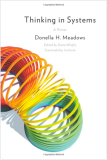 The last two books that I would suggest in reading have to do with two of the most (according to me) interesting developing areas for design nowadays: Service Design and Systems thinking. Both are connected. Systems thinking explains the way service design can be approached. Donella Meadows (RIP) a pioneering environmental scientist has a simple primer called “Thinking in Systems”. In an affordable book, she introduces tools, concepts and ways of tackling problems through this lens. She uses stories and some basic graphs to illustrate her points and also touches on “leverage points” (like information flows, critical nodes, etc.), which are one of the basics for assessments of systems through design. Lastly, I would recommend that you read “This is Service Design Thinking: Basics”. If you are not a design/engineer researcher or an anthropologist writing theory on design, this book should be enough.
The last two books that I would suggest in reading have to do with two of the most (according to me) interesting developing areas for design nowadays: Service Design and Systems thinking. Both are connected. Systems thinking explains the way service design can be approached. Donella Meadows (RIP) a pioneering environmental scientist has a simple primer called “Thinking in Systems”. In an affordable book, she introduces tools, concepts and ways of tackling problems through this lens. She uses stories and some basic graphs to illustrate her points and also touches on “leverage points” (like information flows, critical nodes, etc.), which are one of the basics for assessments of systems through design. Lastly, I would recommend that you read “This is Service Design Thinking: Basics”. If you are not a design/engineer researcher or an anthropologist writing theory on design, this book should be enough.  It is definitely a Primer. With a very cute and useful information design layout, the authors just put upfront basic concepts and useful canvases to work with service design tools. If you enjoyed Alexander Osterwalder‘s Business Model Generation book, you will enjoy this 23 international author’s textbook as it works with the same formula. An application-based visual thinking material that portrays cases that can be replicated or used as learning platforms.
It is definitely a Primer. With a very cute and useful information design layout, the authors just put upfront basic concepts and useful canvases to work with service design tools. If you enjoyed Alexander Osterwalder‘s Business Model Generation book, you will enjoy this 23 international author’s textbook as it works with the same formula. An application-based visual thinking material that portrays cases that can be replicated or used as learning platforms.
Footprints: Visual Anthropology and Design meet in the work of Saul Flores
 Image: Saul Flores
Image: Saul Flores
I recently came across Saul Flores as we are part of NC State University, in the States. His photographic work [more like visual anthro to me] on “The Walk of the Immigrants” has already been publicized by various places such as TED[x] , NPR and others. But which is the real reason I wanted to mention this project in this humble blog? Because we love to showcase projects that are real an this one is not meaning to do more than provide a window for a personal journey on immigration [and the big walk his own family did]. It’s not a needless fancy project by a huge NGO and is not claiming a “Saving the World” motto, but it is more related to what we have talked on the blog on collaboration and multivocality in the realm of design and anthropology. Here is what Saul writes…
THE WALK OF THE IMMIGRANTS
Saul Flores , photographer [BA in Design and Business, NCSU]
Kickstarter Fundraising URL
“Over the past few years I have dedicated most of my time and energy into a project called the Walk of the Immigrants. The project itself started when I was a Junior at North Carolina State University trying to find a clearer path towards cultural understanding between our communities. As tension rose for Latin America, and for my family, I felt that there was a middle path that needed to be explored to best remind people of the commonalities that we have as one larger community. The solution that I found were photographs. 
Press the image to watch Saul Flores’ Video on Kickstarter
THE JOURNEY
As a result, I began an image-based narrative  that (more…)
that (more…)
